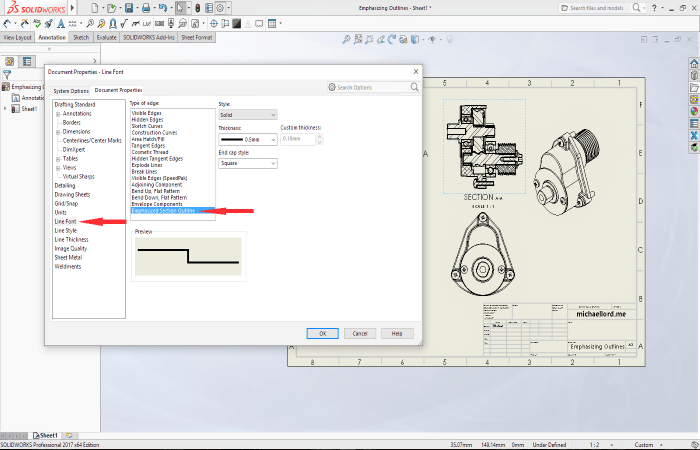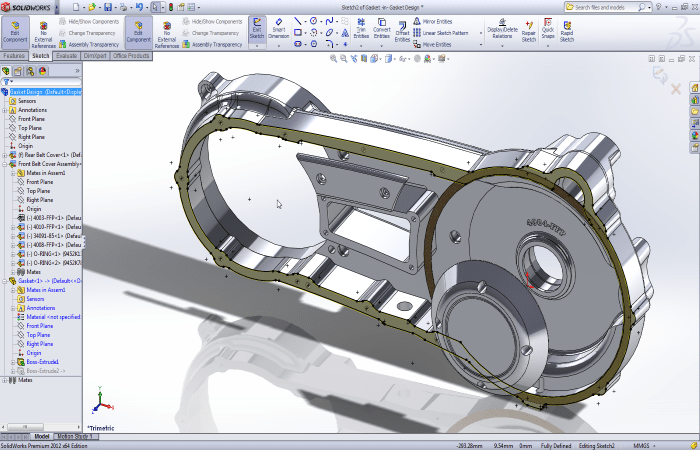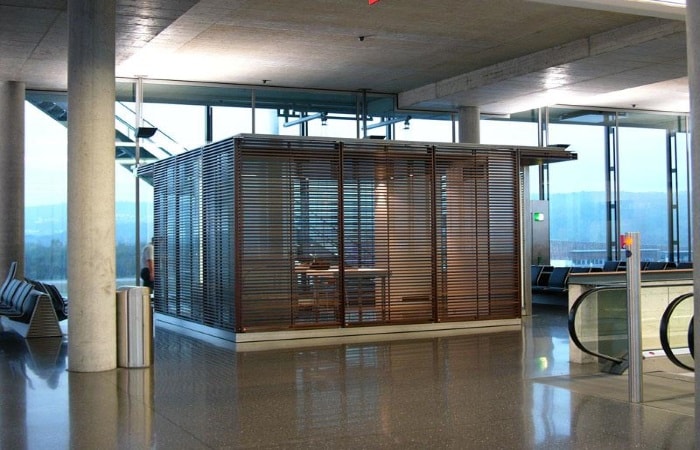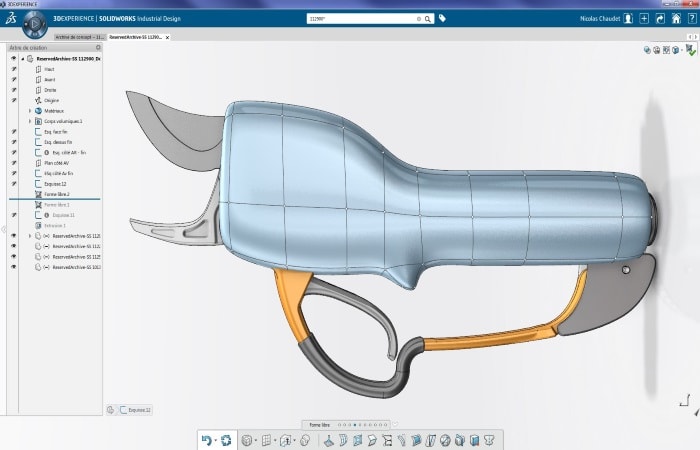SolidWorks is easily one of the most popular CAD packages out there. Accordingly, it’s used by industries and sectors worldwide. A 2D and 3D parametric modeler, SolidWorks is integral to most drafting and engineering processes. With the job market for engineering, design and architecture being so competitive, SolidWorks skills are therefore extremely valuable and sought-after. But what types of SolidWorks careers are on offer? And what qualifications do you need? Scan2CAD, as usual, has all the answers for you!
We’ve put together a guide to everything you need to know about SolidWorks careers. Here, we’ll cover everything from the specific jobs on offer, to the qualifications needed, to where you can find them. Plus, we’ve included a handy stats section examining specific salaries and job growth. Let’s hop to it!
Table of Contents
- SolidWorks careers
- Qualifications
- Essential statistics and information
- Pros & cons
- Where to start
- Conclusion
SolidWorks careers
SolidWorks was developed by CAD giant Dassault Systèmes. It also stands as one of the most prominent CAD packages out there. As CAD has evolved, so too have job requirements. It’s now common for jobs to require candidates to have experience using specific software. This is mostly due to companies having all employees using the same software. Being proficient in SolidWorks, therefore, can open many doors for you.
Already had a look at job sites? You’ll have noticed that some jobs specifically mention CAD software, e.g., “SolidWorks drafting specialist”. Alternatively, you might find the software mentioned in the job description. We’re going to take a look at general career sectors that require skills in SolidWorks:
- Drafting
- Engineering
- Architecture
- Design
Drafting

Image source: Michael Lord
Drafters can use SolidWorks to create 2D and 3D drawings. They’ll work with engineers to put together blueprints, plans, parts and assembly drawings. Furthermore, drafters will have to specify aspects like tolerance, dimensions and materials. CAD drafters, therefore, are fundamental in the process of creating structures, machines and products. One of the benefits of CAD is that drafters no longer have to create and continue modifying real-world prototypes. Everything can be modified and improved directly in SolidWorks. Drafters can even test real-world scenarios in simulations.
Mechanical Drafter
Median annual wage: $55,130
If the name didn’t clue you in, mechanical drafters specialize in creating and preparing drawings for various machinery, mechanical tools and devices. Whether it’s medical equipment or heavy industry tools, mechanical drafters play a huge part. Accuracy plays a heavy role in these technical drawings—drafters are required to indicate dimensions, assembly methods and mechanical installation infrastructure. Mechanical drafters can expect to work alongside engineers, manufacturers and architects.
Mechanical drafters are required to verify design calculations, which is where SolidWorks can play a big part, as simulation sequences can be used to test stress and tolerance. This means that drafters can quickly assess a product’s functionality and make necessary changes quickly and efficiently.
Electrical Drafter
Median annual wage: $59,690
Electrical drafters create technical illustrations, wiring diagrams and connection specifications that are used as visual aids for complex equipment and machinery. These drawings will consequently be used by electrical workers who are installing or repairing equipment. Electrical drafters will ultimately work towards creating master drawings—to scale—which will give engineers an idea as to where these installations will be placed in existing facilities.
Accuracy is key. Electrical drafters have to take note of exact dimensions and specifications. For example, they would need to look at factors that might affect the installation, such as distance for wire. Fortunately, SolidWorks comes with a range of simulation capabilities.
Architectural drafter
Median annual wage: $52,870
You might be wondering what the difference is between architects and architectural drafters. For the most part, architectural drafters take the concepts of architects and create technical drawings and blueprints. Architects, on the other hand, have a much more “hands-on” approach to projects. By using software like SolidWorks, architectural drafters can take the rough sketches created by architects to design full, detailed schematics.
SolidWorks is relatively popular in the AEC sector for its optimized construction process—courtesy of PDM—and its ability to connect design data from start to construction. Indeed, these capabilities have made things much more efficient and streamlined.
Civil drafter
Median annual wage: $52,870
Civil drafters create drawings, maps and schematics for large-scale civil engineering projects. These projects could be anything from roads to bridges to sewage systems. This wide variety also means that you could be working on blueprints and drawings for projects either above or below ground! Civil drafters also need to take into consideration factors like cost and material type—consequently calculating how this might affect the weight and volume of the design.
It’s not all about looks, of course. It’s a civil drafter’s job to make sure everything functions the way it’s supposed to. Projects need to be to scale, accurately dimensioned and within the correct procedure and safety standards. As with architectural drafters, civil drafters take the ideas of civil engineers and put them to paper—or CAD!
Engineering

Image source: Engineer.com
SolidWorks is very popular with engineers—allowing them to produce detailed designs and schematics for the creation of mechanical systems or products. They can start out with 2D designs, eventually evolving to full 3D models. Analysis and simulation tools in SolidWorks can then be used to test stress and tolerance—trying to prevent issues further along the pipeline. Aspects like cost, material and measurements can also be examined throughout the design process.
Mechanical Engineer
Median annual wage: $85,880
Mechanical engineers offer solutions—in the form of mechanical devices or processes—to particular problems. These products can range from anything including electrical generators, gas turbines and elevators. Using SolidWorks, mechanical engineers can create these mechanical devices—making use of important analysis tools to test stress and tolerance.
Obviously, if any problems are found, such as weak structures or overlapping elements, the engineer will need to make modifications. Fortunately, you no longer have to go back to the drawing board and scrap an entire design if there are issues. It’s as simple as identifying the problem and modifying it.
Civil Engineer
Median annual wage: $84,770
Civil engineers have to cope with vast amounts of information during a project, from survey reports to maps to overall data. It’s their job to measure construction costs—measured up against budgets—regulations, potential environmental hazards and general risk analysis. With SolidWorks, PDM can play a huge role in this part of the job. Of course, that’s just the tip of the iceberg. They also have to consider cost estimates for materials, machinery and labor.
Once civil engineers have surveyed and analyzed the structure, they’ll present their findings to the public. To that end, visual aids play a big role in this particular part.
Industrial Engineer
Median annual wage: $85,880
Industrial engineers have one key factor that they need to consider above all: efficiency. It’s their job to develop management systems and workflows that make planning and cost analysis as efficient as possible. Industrial engineers also work on individual projects—figuring out how to create products with maximum efficiency. The aim is to eliminate wastefulness from processes.
Industrial engineers are also in charge of quality control procedures and reviewing work and process flows. It’s not all about machines or products: it’s also about the people. Industrial engineers look at the workforce and evaluate how well they’re doing their jobs.
Other engineering careers might include manufacturing engineers, project engineers and application engineers.
Architecture

Image source: Solid Solutions
While SolidWorks might not be the first CAD software people think of in regards to architecture—the most obvious one might be AutoCAD—it can be very useful. SolidWorks can be used to create 2D floor plans, 3D models and visual renderings of a variety of possible structures. And that’s not all. Capabilities like PDM and simulations enable users to streamline workflows and perfect a structure.
Architect
Median annual wage: $78,470
Architects work alongside architectural drafters, as shown above, who take their ideas to CAD—reviewing drawings and specifications. Architects might start by selecting the site of the structure. They will then need to look at the specific requirements, objectives and budget of the overall project. Obviously, the architect won’t be working alone—they’ll collaborate with other architects, drafters and engineers. The benefit of software like SolidWorks is that collaboration is simple—everything is completely streamlined from step to step.
It’s not all about CAD and working behind a computer, however. Architects will also be expected to take regular visits to the actual site of the project. This is so they can check the progress of the project and ensuring it’s on time—and sticking to the budget!
Design

Image source: SolidWorks blog
Using SolidWorks, designers can put together visual interpretations of projects and 3D renderings—useful for presenting work to clients. Whether it’s interior or exterior design, models can include a variety of elements including windows, wall furnishings and flooring. SolidWorks’ simulation capabilities can play a role in enabling designers to perfect designs before heading to the physical prototype stage.
Interior Designer
Median annual wage: $51,500
Interior designers create interior spaces—taking into consideration client specifications and aesthetics. Space plays a huge role in projects, as interior designers need to consider how to use free space and how people will move around it. Using SolidWorks, interior designers can create detailed floor plans and layouts—even including electrical layouts.
Designers need to specify materials and interior furnishings, ranging from lighting to the walls to the flooring. Visual tools are incredibly useful in allowing designers to show their full ideas and concepts to clients in a clear and effective manner. To make it even more realistic, designers can choose to present clients with full walkthroughs.
Industrial Designer
Median annual wage: $65,970
It’s the job of industrial designers to consider how people use products, and to test different design types to determine which one is safest, most efficient and ideal for the target audience. Working with engineers, industrial designers also need to determine whether their design is indeed possible. Whilst creating their product in SolidWorks, industrial designers will look at material and production costs.
Using analysis tools, industrial designers will evaluate their designs, looking at safety, appearance and overall functionality. They’ll continue to revise their product until it is the best possible model. Much like interior designers, they’ll also present their designs to clients via visual tools and walkthroughs.
Qualifications
So, we’ve looked at the many SolidWorks careers that are available out there. Now, you might be wondering how exactly you can become a drafter or engineer, for example. We’re going to look into the specific certificates and degrees that you might need.
Before we do, however, we’re going to briefly explain the different qualifications available.
- Professional certificate. This is offered at community colleges, career training schools and online schools. It can be obtained in a year and offers specific career skills.
- Associate’s degree. It takes two years at a community college, career training school or college/university. It’s possible to continue on to do a bachelor’s degree.
- Bachelor’s degree. It takes four or five years at a college/university or online school. Most jobs require this type of degree. It’s possible to continue on to do a master’s.
- Master’s degree. It’s taken after a bachelor’s degree and can be completed in 2 years. It gives students a more advanced look at their field of study.
What you need to become…
A drafter
If you’re looking to become a drafter, you need—at the very least—an associate’s degree. As we’ve said, this can be completed at a community college, career training school or college/university. You can opt to specialize in a particular field, e.g. electrical, mechanical or architectural. Once you’ve completed your degree, you can choose to further your education with a bachelor’s, or start looking for a job. Most opt for a bachelor’s degree due to increased job prospects.
With regards to licenses, you can opt to get American Design Drafting Association (ADDA) certification. While not mandatory, it can improve your résumé and emphasize your competence and knowledge in your chosen field of expertise.
An engineer
Requirements for engineers are slightly higher than drafters. You need to complete a bachelor’s degree in a subject relevant to your sector. With engineering being highly competitive, you might also opt for a master’s degree to set you apart from the rest.
As is the case with drafters, it’s not mandatory for engineers to have specific certifications. That being said, if you’re eyeing up positions like senior mechanical engineer, a Professional Engineering (PE) license will set you up nicely.
An architect
To start, you need a bachelor’s degree in architecture. If you’ve had no prior training, this can take up to 5 years. You’ll also want to add on a master’s degree which can take between 1 to 5 years. And that’s not even half of it! You need to complete at least 3 years of experience in a paid internship.
Unlike drafters and engineers, architects are all required to sit for the Architect Registration Examination (ARE). If you’re looking to bolster your résumé, you might look towards further certification with NCARB.
A designer
As with engineers, designers need to complete a bachelor’s degree in their chosen field, e.g., interior design or engineering. With this particular sector, it’s unquestionably worth building up a portfolio of your work over the years. This will give potential employers an idea of your capabilities. Moreover, it’s a great way to track your progress.
Some states only allow individuals to use the title “interior designer” if they’ve completed the NCIDQ. You need 2 years of experience to be eligible. And, while industrial designers don’t have to have specific certification, most opt for an MBA to further their skills.
Essential statistics and job information
A bit lost? There’s a lot of information to take in with these jobs. Fortunately, we’ve put together a table below with all the essential bits you need to know. This includes median annual salary, education and additional requirements. Additionally, we’ve included a job growth projection over the next 10 years.
| Career | Median Annual Wage | Required Education | Additional requirements | Projected Job Growth (2016-26) |
| Mechanical drafter | $55,130 | Associate’s degree/Bachelor’s degree (optional) | ADDA optional | 5% |
| Electrical drafter | $59,690 | Associate’s degree/Bachelor’s degree (optional) | ADDA optional | 2% |
| Architectural drafter | $52,870 | Associate’s degree/Bachelor’s degree (optional) | ADDA optional | 7% |
| Civil drafter | $52,870 | Associate’s degree/Bachelor’s degree (optional) | ADDA optional | 9% |
| Mechanical engineer | $85,880 | Bachelor’s degree/Master’s degree (optional) | PE for career advancement | 9% |
| Civil engineer | $84,770 | Bachelor’s degree/Master’s degree (optional) | PE for career advancement | 11% |
| Industrial engineer | $85,880 | Bachelor’s degree/Master’s degree (optional) | PE for career advancement | 10% |
| Architect | $78,470 | Bachelor’s degree/Master’s degree | 3 years of paid experience, mandatory ARE, NCARB optional | 4% |
| Interior designer | $51,500 | Bachelor’s degree | NCIDQ required in some states | 4% |
| Industrial designer | $65,970 | Bachelor’s degree | MBA optional | 4% |
Source: Bureau of Labor Statistics
SolidWorks careers: pros & cons
If our guide to SolidWorks careers has you interested, check out our quick list of pros and cons to see if it really is right for you…
Pros





Cons





Overall, you have to think carefully about how much time, money and effort you’ll have to put in. Careers in engineering undeniably have higher monetary benefits than drafting. That being said, you’ll also have to put in more time and effort in gaining a bachelor’s or master’s degree. Additionally, to keep up in such a competitive industry, you’ll have to make sure your knowledge of SolidWorks is consistent and up to date.
SolidWorks careers: where to start?

So, you’ve slowly accumulated your SolidWorks skills and now you’re eager to put them to the test. If you’ve already got your degree sorted out, now’s the time for the hardest part: searching for a job. Fortunately, nowadays, the entire job search process has been simplified. Subsequently, there are hundreds of job sites out there that you can use. Some of our top ones include:
Simply use relevant keywords—like “SolidWorks” or “Mechanical Engineer”—and refine your search by location, salary preferences and experience. In short, make sure you take the time to read the job descriptions carefully and revise your résumé until it’s up to scratch.
Conclusion
SolidWorks fans will be pleased, then! With so many SolidWorks careers out there, the options are limitless. A plan is key to career success. So, map out where you want to be and take note of what you need to get there. Whether it’s getting an associate’s degree or gaining experience, it’s all important.
Concerned about job growth stats? While it’s plain to see that some jobs have a higher projected job growth percentage, it’s not an exact science. In any case, there’s always opportunity out there, it’s all about looking carefully. For that reason, it’s important to do your research properly and tailor your résuméto fit prospective jobs—the rest will undoubtedly fall into place.
Looking to start out on your own? Then you might want to check out Freelance CAD—Everything You Need To Know.




